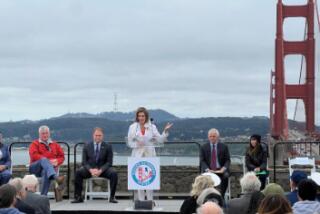Bridge District Seeking, Selling Gifts
- Share via
SAN FRANCISCO — The Golden Gate Bridge spans some troubled waters.
The agency that operates the world-famous landmark, along with a bus and ferry system, is facing tough financial times.
Officials have a projected five-year, $139-million deficit, even after raising tolls and transit fares, slashing bus service and laying off employees. As a result, the Golden Gate Bridge District is hitting up tourists for cash.
A donation box, placed at the foot of the bridge in June, has collected more than $1,000, and officials plan to put out several more boxes in the coming months. They also are selling limited-edition Christmas tree ornaments with the bridge logo for $24.99, and opened a new parking area with 50 spaces for weekend use at $5 a day.
One afternoon last week, tourists from Australia, China, Germany, India and Uruguay flocked to take photos next to a bridge display, but they didn’t seem to notice the collection box nearby.
Some local residents and bridge district critics, meanwhile, are reacting in disbelief.
“It’s totally laughable,” said Susan Deluxe of Tiburon, a longtime bridge district gadfly. “What’s next? Will they charge us to look at it?”
Deluxe was so incensed a decade ago by the first of two toll increases that she helped write “I Got Ripped Off on My Way to San Francisco,” a takeoff on the song celebrating the city that has been most famously sung by Tony Bennett.
The latest toll increase a year ago, to $5 -- the highest for any bridge in the Bay Area -- again angered Deluxe and other critics.
They have said the bridge district should be disbanded and operations turned over to Caltrans, the state transportation agency that operates seven other bridges in the Bay Area and charges $2 tolls.
Fielding Greaves, secretary of the Marin United Taxpayers Assn., said he supports that idea or a plan that would allow the district to operate the bridge alone while turning over the transit services to other entities.
He minced no words about how he felt about the bridge district’s latest pitch for donations. “It’s a very feeble gesture,” Greaves said. “It’s a sign of their lack of imagination and incompetence. They’ve been running that bridge district into a growing deficit for a long time.”
Cynthia Murray, a Marin County supervisor and bridge board director, said she saw nothing wrong with the collection boxes. She said, “I guess it just shows the depth of our concern. We’re trying to go to any length to raise money to preserve services.”
The collection box idea was proposed last year after bridge officials decided against imposing a toll on pedestrians and bicyclists. But they did raise the auto toll from $3 to $5 -- $4 with a discount pass.
Mary Currie, a spokeswoman for the bridge district, disagreed with critics who say the district is poorly run. She said Caltrans can charge lower tolls on other Bay Area bridges because it is not subsidizing a transit system.
Currie attributed the bridge district’s financial problems to a combination of a drop in bus and ferry ridership and a reduction in the number of commuters crossing the bridge from Marin and Sonoma counties to reach San Francisco. She cited an economic downturn and increasing costs, including $2 million to $2.5 million alone for extra security on the bridge after the Sept. 11 terrorist attacks.
The bridge district has been in such severe financial straits that it slashed bus service by a third last month, eliminated 171 positions this year and increased bus and ferry fares in July.
Currie said bridge officials anticipated a $454-million deficit over five years when they first made their projections two years ago. But increasing the bridge toll, continuing a hiring freeze and deferring capital improvements helped reduce that figure to $202 million. After more recent actions, including the cut in bus service, layoffs and increased transit fares, the deficit dropped to $139 million.
The district’s efforts to boost revenue include the sale of the Christmas tree ornaments. Currie said bridge officials haven’t advertised the ornaments, but they are available at the bridge gift shop and on the district’s Web site at www.goldengatebridge.org.
Currie said bridge officials had modeled the program on a similar one at the White House, which began in 1981 with sales of less than 2,000 ornaments. Last year, she said, almost 1 million worth of the ornaments were sold, making it the nation’s single biggest-selling Christmas ornament program.
She said bridge officials hope to make their ornament sale an annual event and already are designing a new one for next year.
More to Read
Sign up for Essential California
The most important California stories and recommendations in your inbox every morning.
You may occasionally receive promotional content from the Los Angeles Times.










